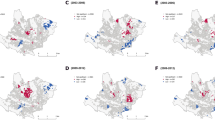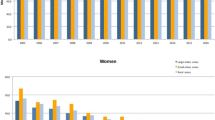Abstract
Inhabitants of deprived neighbourhoods are at higher risk of coronary heart disease. In this study we investigate the hypothesis that social inequalities at neighbourhood level become already manifest in subclinical coronary atherosclerosis, as defined by electron-beam computed tomography derived measures. Coronary artery calcification was assessed as a marker of atherosclerosis in a population based sample of 4301 men and women (45–75 years) without a history of coronary heart disease. Participants lived in three adjacent cities in Germany and were examined between 2000 and 2003 as part of the Heinz Nixdorf Recall Study. Individual level data was combined with neighbourhood level information about unemployment, welfare and living space per inhabitant. This dataset was analysed with descriptive and multilevel regression methods. An association between neighbourhood deprivation and subclinical coronary calcification was observed. After adjustment for age and individual socioeconomic status male inhabitants of high unemployment neighbourhoods had an odds ratio of 1.45 (1.11, 1.96) of exhibiting a high calcification score (>75th percentile) compared to men living in low unemployment areas. The respective odds for women was 1.29 (0.97, 1.70). Additional explorative analyses suggest that clustering of unhealthy lifestyles in deprived neighbourhoods contributes to the observed association. In conclusion, findings suggest that certain neighbourhood characteristics promote the emergence of coronary atherosclerosis. This might point to a pathway from neighbourhood deprivation to manifest coronary heart disease.
Similar content being viewed by others
Abbreviations
- BMI:
-
Body mass index
- CAC:
-
Coronary artery calcification
- CHD:
-
Coronary heart disease
- EBCT:
-
Electron-beam computed tomography
- HNR:
-
Heinz Nixdorf Recall Study
- SES:
-
Socioeconomic status
References
Borrell LN, Diez Roux AV, Rose K, Catellier D, Clark BL. Atherosclerosis Risk in Communities Study. Neighbourhood characteristics and mortality in the Atherosclerosis Risk in Communities Study. Int J Epidemiol. 2004;33:398–407. doi:10.1093/ije/dyh063.
Chaix B, Rosvall M, Merlo J. Recent increase of neighborhood socioeconomic effects on ischemic heart disease mortality: a multilevel survival analysis of two large Swedish cohorts. Am J Epidemiol. 2007;165:22–6. doi:10.1093/aje/kwj322.
Diez Roux AV, Merkin SS, Arnett D, Chambless L, Massing M, Nieto FJ, et al. Neighborhood of residence and incidence of coronary heart disease. N Engl J Med. 2001;345:99–106. doi:10.1056/NEJM200107123450205.
Diez Roux AV, Borrell LN, Haan M, Jackson SA, Schultz R. Neighbourhood environments and mortality in an elderly cohort: results from the cardiovascular health study. J Epidemiol Community Health. 2004;58:917–23. doi:10.1136/jech.2003.019596.
Engstrom G, Goransson M, Hansen O, Hedblad B, Tyden P, Todt T, et al. Trends in long-term survival after myocardial infarction: less favourable patterns for patients from deprived areas. J Intern Med. 2000;248:425–34. doi:10.1046/j.1365-2796.2000.00757.x.
Macintyre K, Stewart S, Chalmers J, Pell J, Finlayson A, Boyd J, et al. Relation between socioeconomic deprivation and death from a first myocardial infarction in Scotland: population based analysis. BMJ. 2001;322:1152–3. doi:10.1136/bmj.322.7295.1152.
Stjärne MK, Fritzell J, De Leon AP, Hallqvist J, SHEEP Study Group. Neighborhood socioeconomic context, individual income and myocardial infarction. Epidemiology. 2006;17:14–23. doi:10.1097/01.ede.0000187178.51024.a7.
Forastiere F, Stafoggia M, Tasco C, Picciotto S, Agabiti N, Cesaroni G, et al. Socioeconomic status, particulate air pollution, and daily mortality: differential exposure or differential susceptibility. Am J Ind Med. 2007;50:208–16. doi:10.1002/ajim.20368.
Petersen KL, Bleil ME, McCaffery J, Mackey RH, Sutton-Tyrrell K, Muldoon MF, et al. Community socioeconomic status is associated with carotid artery atherosclerosis in untreated, hypertensive men. Am J Hypertens. 2006;19:560–6. doi:10.1016/j.amjhyper.2005.12.008.
Nordstrom CK, Diez Roux AV, Jackson SA, Gardin JM. Cardovascular Health Study. The association of personal and neighborhood socioeconomic indicators with subclinical cardiovascular disease in an elderly cohort. The cardiovascular health study. Soc Sci Med. 2004;59:2139–47. doi:10.1016/j.socscimed.2004.03.017.
Gee GC, Payne-Sturges DC. Environmental health disparities: a framework integrating psychosocial and environmental concepts. Environ Health Perspect. 2004;112:1645–53.
van Lenthe FJ, Mackenbach JP. Neighbourhood and individual socioeconomic inequalities in smoking: the role of physical neighbourhood stressors. J Epidemiol Community Health. 2006;60:699–705. doi:10.1136/jech.2005.043851.
Diez-Roux AV. Residential environments and cardiovascular risk. J Urban Health. 2003;80:569–89. doi:10.1093/jurban/jtg065.
Dragano N, Bobak M, Wege N, Peasey A, Verde PE, Kubinova R, et al. Neighbourhood socioeconomic status and cardiovascular risk factors: a multilevel analysis of nine cities in the Czech Republic and Germany. BMC Public Health. 2007;7:255. doi:10.1186/1471-2458-7-255.
van Lenthe FJ, Brug J, Mackenbach JP. Neighbourhood inequalities in physical inactivity: the role of neighbourhood attractiveness, proximity to local facilities and safety in the Netherlands. Soc Sci Med. 2005;60:763–75. doi:10.1016/j.socscimed.2004.06.013.
Carson AP, Rose KM, Catellier DJ, Kaufman JS, Wyatt SB, Diez-Roux AV, et al. Cumulative socioeconomic status across the life course and subclinical atherosclerosis. Ann Epidemiol. 2007;17:296–303. doi:10.1016/j.annepidem.2006.07.009.
Rosvall M, Engström G, Hedblad B, Janzon L, Berglund G. Area social characteristics and carotid atherosclerosis. Eur J Public Health. 2007;17:333–9. doi:10.1093/eurpub/ckl239.
Wagenknecht LE, Langefeld CD, Freedman BI, Carr JJ, Bowden DW. A comparison of risk factors for calcified atherosclerotic plaque in the coronary, carotid, and abdominal aortic arteries: the diabetes heart study. Am J Epidemiol. 2007;166:340–7. doi:10.1093/aje/kwm091.
Rumberger JA, Simons DB, Fitzpatrick LA, Sheedy PF, Schwartz RS. Coronary artery calcium area by electron-beam computed tomography and coronary atherosclerotic plaque area. A histopathologic correlative study. Circulation. 1995;92:2157–62.
Lamonte MJ, Fitzgerald SJ, Church TS, Barlow CE, Radford NB, Levine BD, et al. Coronary artery calcium score and coronary heart disease events in a large cohort of asymptomatic men and women. Am J Epidemiol. 2005;162:421–9. doi:10.1093/aje/kwi228.
Schmermund A, Möhlenkamp S, Stang A, Grönemeyer D, Seibel R, Hirche H, et al. Assessment of clinically silent atherosclerotic disease and established and novel risk factors for predicting myocardial infarction and cardiac death in healthy middle-aged subjects: rationale and design of the Heinz Nixdorf Recall Study. Am Heart J. 2002;144:212–8. doi:10.1067/mhj.2002.123579.
Stang A, Moebus S, Dragano N, Beck E, Möhlenkamp S, Schmermund A, et al. Baseline recruitment and analyses of nonresponse of the Heinz Nixdorf Recall Study: identifiability of phone numbers as the major determinant of response. Eur J Epidemiol. 2005;20:489–96. doi:10.1007/s10654-005-5529-z.
Schmermund A, Möhlenkamp S, Berenbein S, Pump H, Moebus S, Roggenbuck U, et al. Population-based assessment of subclinical coronary atherosclerosis using electron-beam computed tomography. Atherosclerosis. 2006;185:177–82. doi:10.1016/j.atherosclerosis.2005.06.003.
Schmermund A, Lehmann N, Bielak LF, Yu P, Sheedy PF, Cassidy-Bushrow AE, et al. Comparison of subclinical coronary atherosclerosis and risk factors in unselected populations in Germany and US-America. Atherosclerosis. 2007;195:e207–16. doi:10.1016/j.atherosclerosis.2007.04.009.
Agatston AS, Janowitz WR, Hildner FJ, Zusmer NR, Viamonte M, Detrano R. Quantification of coronary artery calcium using ultrafast computed tomography. J Am Coll Cardiol. 1990;15:827–32.
Executive summary of the third report of the national cholesterol education program (NCEP) expert panel on detection, evaluation and treatment of high blood cholesterol in adults (Adult Treatment Panel III). JAMA. 2001;285:2486–97. doi:10.1001/jama.285.19.2486
UNESCO. International Standard Classification of Education. ISCED 1997. Paris: UNESCO; 1997.
Hoffmann B, Moebus S, Stang A, Beck E, Dragano N, Möhlenkamp S, et al. Residence close to high traffic and prevalence of coronary heart disease. Eur Heart J. 2006;27:2696–702. doi:10.1093/eurheartj/ehl278.
Naess O, Piro FN, Nafstad P, Davey Smith G, Leyland AH. Air pollution, social deprivation, and mortality. A multilevel cohort study. Epidemiology. 2007;18:686–94.
Hoffmann B, Moebus S, Möhlenkamp S, Stang A, Lehmann N, Dragano N, et al. Residential exposure to traffic is associated with coronary atherosclerosis. Circulation. 2007;116:489–96. doi:10.1161/CIRCULATIONAHA.107.693622.
Cubbin C, Sundquist K, Ahlen H, Johansson SE, Winkleby MA, Sundquist J. Neighborhood deprivation and cardiovascular disease risk factors: protective and harmful effects. Scand J Public Health. 2006;34:228–37. doi:10.1080/14034940500327935.
Sundquist J, Malmstrom M, Johansson SE. Cardiovascular risk factors and the neighbourhood environment: a multilevel analysis. Int J Epidemiol. 1999;28:841–5. doi:10.1093/ije/28.5.841.
Davey Smith G, Hart C, Watt G, Hole D, Hawthorne V. Individual social class, area-based deprivation, cardiovascular disease risk factors, and mortality: the Renfrew and Paisley study. J Epidemiol Community Health. 1998;52:399–405.
Chaix B, Chauvin P. Tobacco and alcohol consumption, sedentary lifestyle and overweightness in France: a multilevel analysis of individual and area-level determinants. Eur J Epidemiol. 2003;18:531–8. doi:10.1023/A:1024642301343.
Stang A, Moebus S, Möhlenkamp S, Dragano N, Schmermund A, Beck EM, et al. Algorithms for converting Hawksley random zero to automated oscillometric blood pressure values and vice versa. Am J Epidemiol. 2006;164:85–94. doi:10.1093/aje/kwj160.
Jackson C, Best N, Richardson S. Hierarchical related regression for combining aggregate and individual data in studies of socio-economic disease risk factors. J R Stat Soc Ser A. 2008;171:159–178.
Breslow NE, Clayton DG. Approximate inference in generalized linear mixed models. J Am Stat Assoc. 1993;88:9–25. doi:10.2307/2290687.
Pollitt RA, Kaufman JS, Rose KM, Diez-Roux AV, Zeng D, Heiss G. Early-life and adult socioeconomic status and inflammatory risk markers in adulthood. Eur J Epidemiol. 2007;22:55–66. doi:10.1007/s10654-006-9082-1.
Pickett KE, Pearl M. Multilevel analyses of neighbourhood socioeconomic context and health outcomes: a critical review. J Epidemiol Community Health. 2001;55:111–22. doi:10.1136/jech.55.2.111.
Riva M, Gauvin L, Barnett TA. Toward the next generation of research into small area effects on health: a synthesis of multilevel investigations published since July 1998. J Epidemiol Community Health. 2007;61:853–61. doi:10.1136/jech.2006.050740.
Babisch W. Transportation noise and cardiovascular risk: updated review and synthesis of epidemiological studies indicate that the evidence has increased. Noise Health. 2006;8:1–29.
Kaufman JS, Maclehose RF, Kaufman S. A further critique of the analytic strategy of adjusting for covariates to identify biologic mediation. Epidemiol Perspect Innov. 2004;1(1):4. doi:10.1186/1742-5573-1-4.
Connolly S, O’Reilly D, Rosato M. Increasing inequalities in health: is it an artefact caused by the selective movement of people? Soc Sci Med. 2007;64:2008–15. doi:10.1016/j.socscimed.2007.02.021.
van Lenthe FJ. Aggregate deprivation and effects on health. In: Siegrist J, Marmot M, editors. Social inequalities in health. Oxford: Oxford University Press; 2006. p. 167–192.
Chaix B, Merlo J, Subramanian SV, Lynch J, Chauvin P. Comparison of a spatial perspective with the multilevel analytical approach in neighborhood studies: the case of mental and behavioral disorders due to psychoactive substance use in Malmö, Sweden, 2001. Am J Epidemiol. 2005;162:171–82. doi:10.1093/aje/kwi175.
Acknowledgments and funding
We thank the Heinz Nixdorf Foundation (Chairman: Dr. jur. G. Schmidt) for generous support of the Heinz Nixdorf Study. The study is also supported by the German Ministry of Education and Science. An additional research grant was received from Imatron Inc., South San Francisco, CA, which produced the EBCT scanners, and GE-Imatron, South San Francisco, CA, after the acquisition of Imatron Inc. Assessment of psychosocial factors and neighbourhood level information is funded by the German Research Council (DFG; Project SI 236/8-1 and SI 236/9-1). We are indebted to the investigative group and the study personnel, in particular E. M. Beck, Dr. M. Bröker-Preuß, U. Roggenbuck. We gratefully acknowledge the collaboration with: Prof. Dr. Grönemeyer and Prof. Dr. R. Seibel. Also we are grateful to H. Feldmann (City Council Bochum), F. Beyer (City Council Essen) and H. J. Libera (City Council Mülheim an der Ruhr).
Author information
Authors and Affiliations
Consortia
Corresponding author
Rights and permissions
About this article
Cite this article
Dragano, N., Hoffmann, B., Stang, A. et al. Subclinical coronary atherosclerosis and neighbourhood deprivation in an urban region. Eur J Epidemiol 24, 25–35 (2009). https://doi.org/10.1007/s10654-008-9292-9
Received:
Accepted:
Published:
Issue Date:
DOI: https://doi.org/10.1007/s10654-008-9292-9




